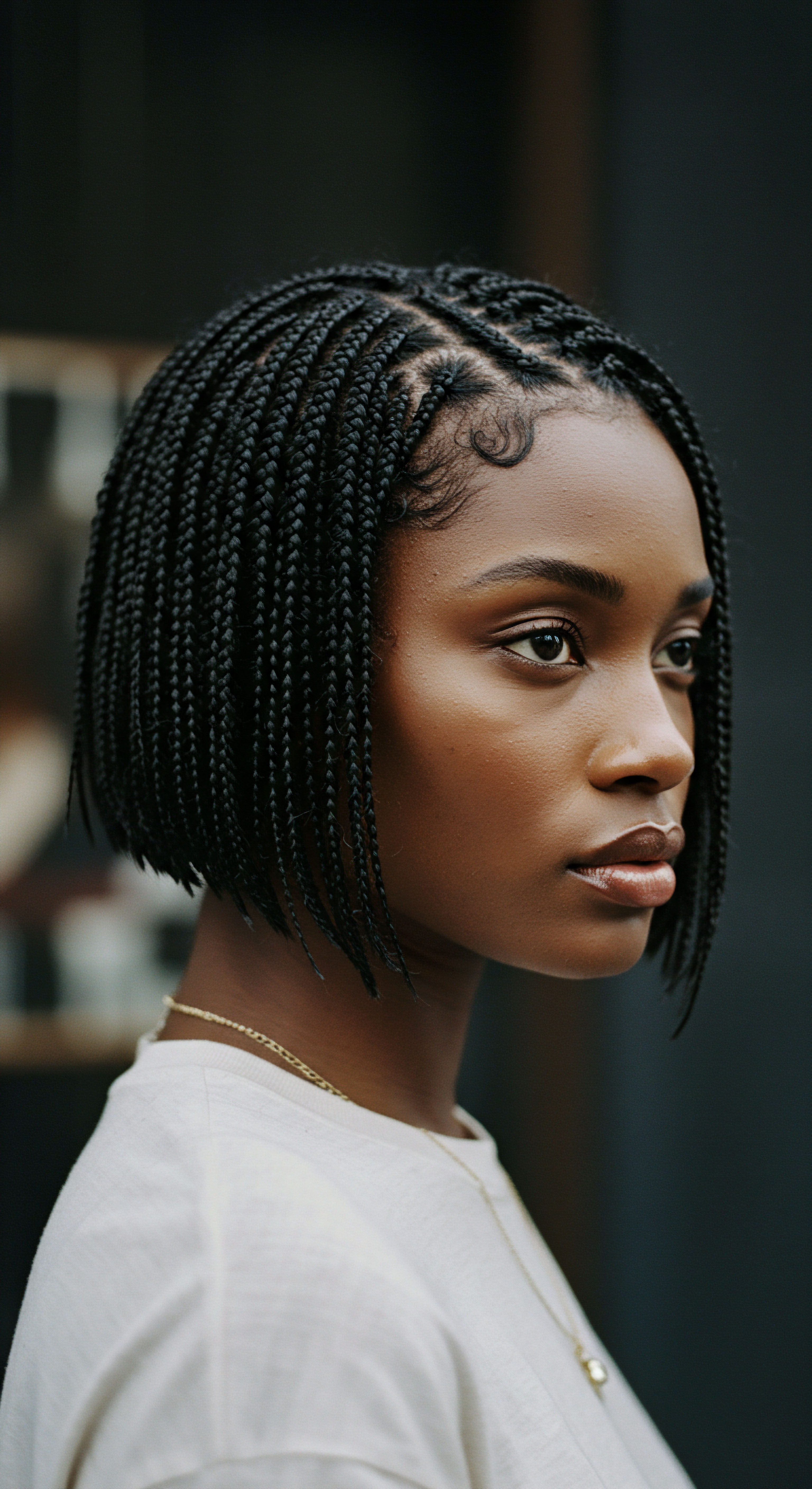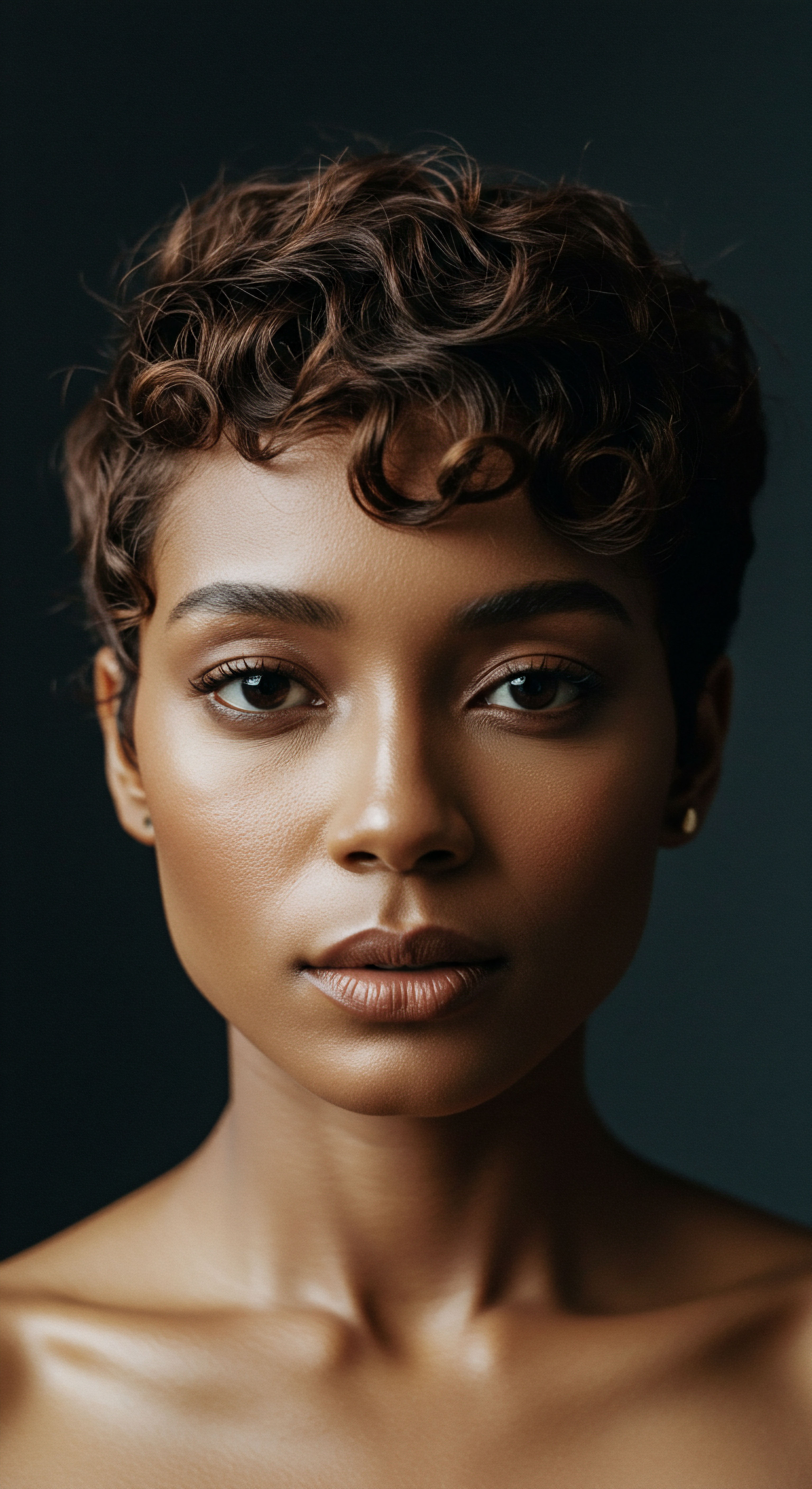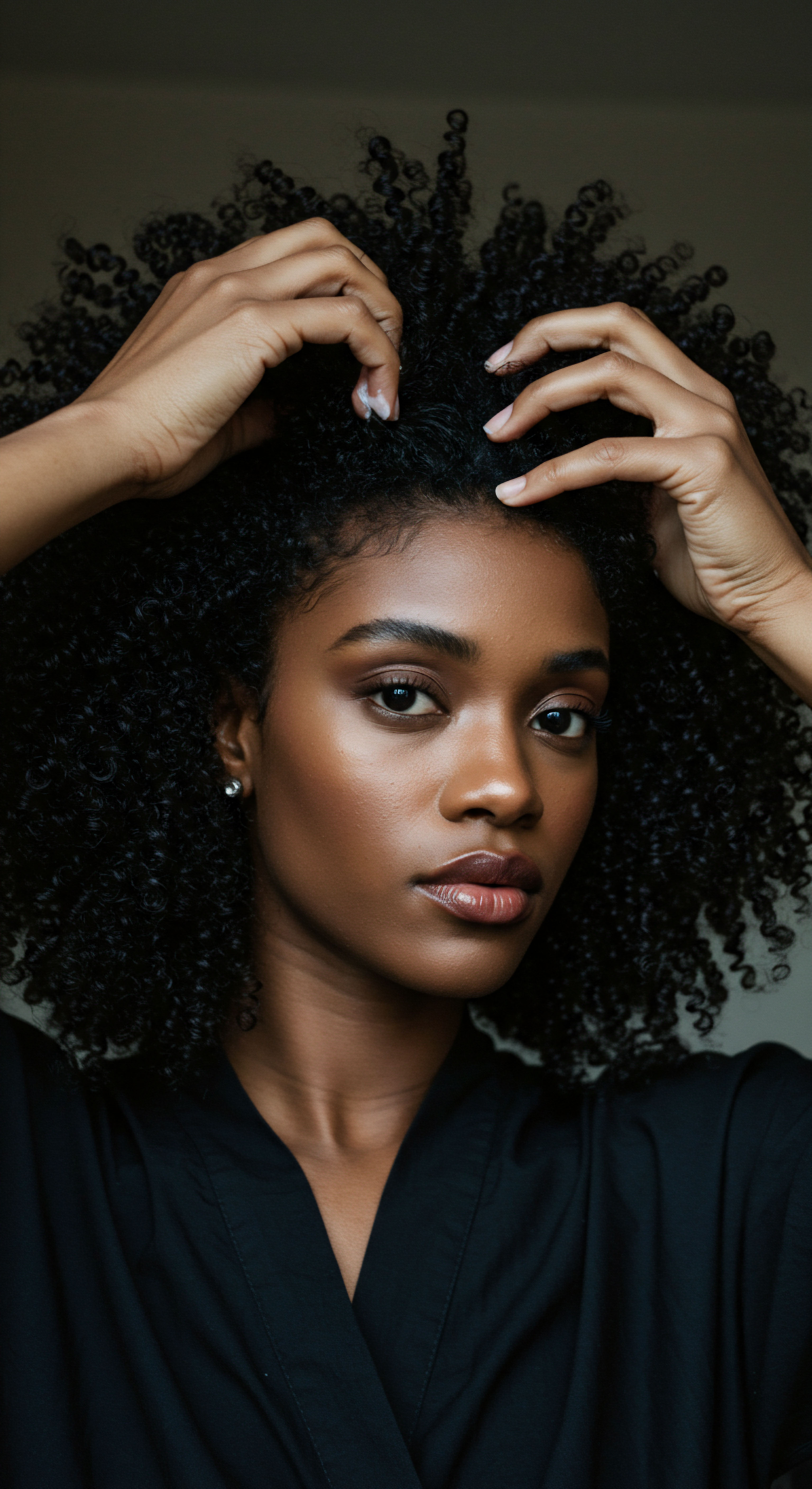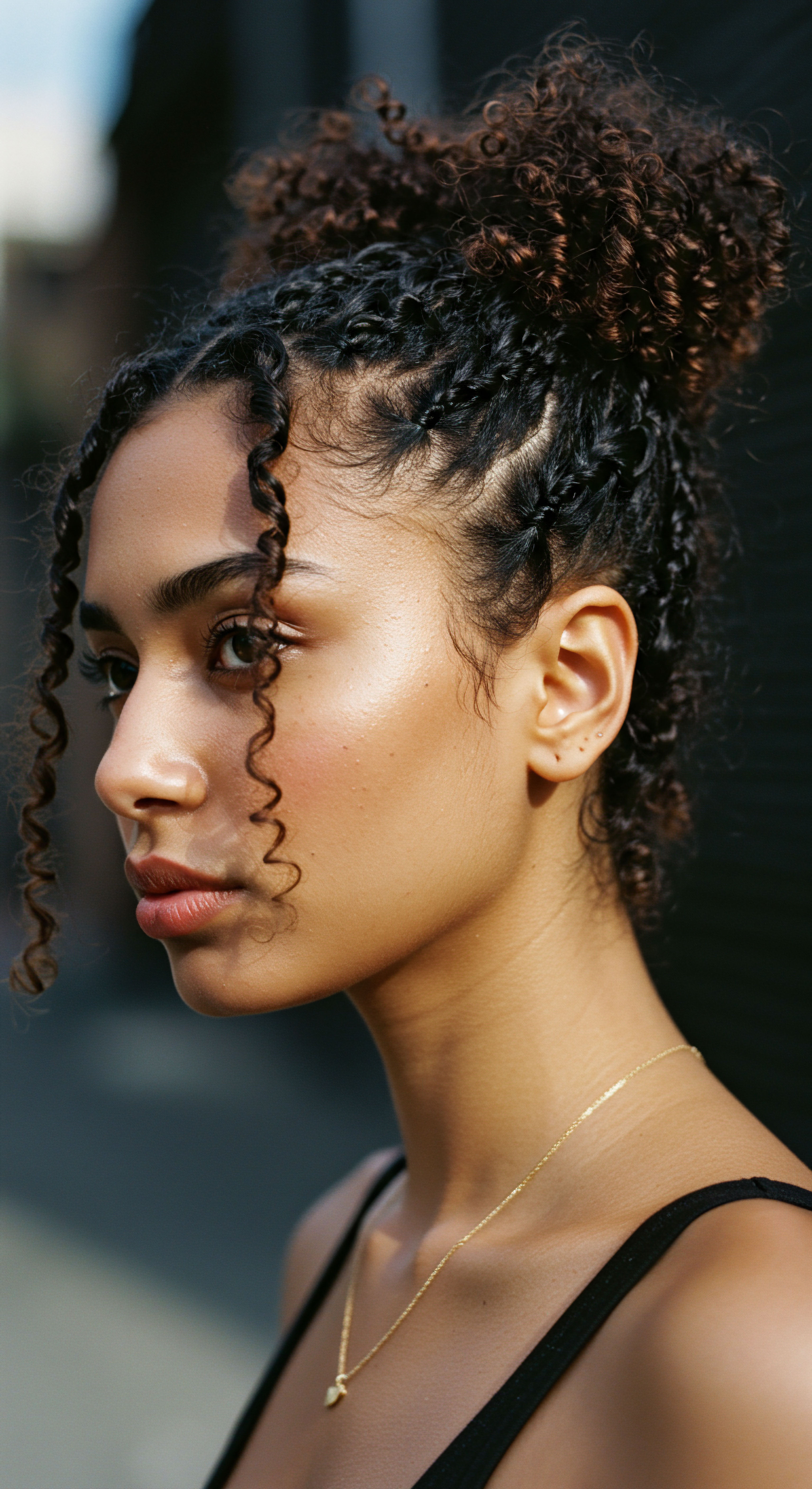
Roots
The story of hair is a story of connection, stretching back through generations, a vibrant strand linking us to those who came before. Before the era of endless product aisles and complex chemical formulations, people around the globe tended to their hair with a deep, intuitive wisdom, drawing directly from the bounty of their surroundings. This ancestral knowledge, passed down through whispers and hands-on practices, offers a gentle invitation to consider how our own hair, particularly textured hair, might truly thrive. It asks us to look beyond the immediate surface and appreciate the enduring relevance of practices rooted in the earth and time.
Understanding hair begins at its very foundation, a journey into its intricate architecture. Each strand, a marvel of biological engineering, possesses a distinct structure that influences its behavior and needs. For textured hair, this involves unique patterns of curl and coil, which shape how light reflects, how moisture moves, and how easily strands can become dry or tangled.

Hair Anatomy and the Textured Strand
A single hair emerges from a follicle, a tiny organ nestled within the scalp. The visible part, the hair shaft, consists of three main layers ❉ the medulla, the cortex, and the cuticle. The medulla forms the innermost core, though it may be absent in finer hair types.
Surrounding this is the cortex, comprising the bulk of the hair, housing the keratin proteins and melanin pigments that give hair its strength and color. The outermost layer, the cuticle, resembles overlapping scales, providing a protective shield.
For textured hair, the shape of the follicle is often elliptical, causing the hair shaft to grow in a helical, or spiral, pattern. This unique growth creates the characteristic curls and coils. The points where the hair bends along its curl pattern become areas of potential vulnerability, as the cuticle layers may not lie as flat as on straight hair, making textured strands more susceptible to moisture loss and external stressors. This inherent design means that care approaches, even those from antiquity, must acknowledge this delicate reality.

Classifying Textured Hair Patterns
Modern systems often categorize textured hair by its curl pattern, ranging from wavy to coily. While these classifications provide a helpful lexicon for contemporary discussions, ancient societies recognized hair diversity through observation and experience, developing practices tailored to different hair types within their communities. They understood that not all hair responded in the same way to the same treatment.
Ancient wisdom offers a profound understanding of hair’s inherent needs, a gentle guide for modern care.
This historical perspective suggests an intuitive grasp of what we now classify as hair porosity or density, even without the scientific terminology. For instance, thicker, denser hair might have been treated with heavier oils, while finer strands received lighter infusions, a testament to practical knowledge accumulated over centuries.
- Follicle Shape ❉ Determines the curl pattern of the hair strand.
- Cuticle Layers ❉ Act as a protective barrier, often more lifted in textured hair.
- Keratin Proteins ❉ Form the primary building blocks of hair strength.

Hair Growth Cycles and Ancient Observations
Hair growth follows a cyclical pattern ❉ anagen (growth), catagen (transition), and telogen (resting). While ancient peoples may not have defined these phases scientifically, their rituals and remedies often supported healthy growth and minimized shedding. Many traditional practices, such as gentle scalp massage, would naturally stimulate blood flow to the follicles, supporting the anagen phase. The emphasis on scalp health in many ancient cultures points to an understanding that a healthy foundation was paramount for vibrant hair.
Consider the practices of various African societies where hair was often seen as a spiritual antenna, requiring careful tending. These societies often used natural emollients and herbs, applied with rhythmic motions, which would soothe the scalp and provide necessary nutrients, intuitively aligning with what we now understand about follicular health.
This foundational knowledge, whether articulated through scientific terms or through generations of observation, remains a quiet constant. The earth provides, and the human spirit, through careful observation and ingenuity, learns to work with it.

Ritual
Stepping from the quiet contemplation of hair’s elemental nature, we arrive at the realm of daily practice, where ancient insights find their tangible expression. The wisdom of our ancestors, far from being mere historical footnotes, provides practical pathways for contemporary hair wellness. This section delves into the actionable methods and tools that have graced human hands for millennia, offering a guide for integrating these timeless practices into our own lives. It invites a reconsideration of what it means to truly care for our strands, moving beyond fleeting trends to enduring traditions.
Across diverse cultures, hair care was not merely about appearance; it was deeply interwoven with personal well-being, community identity, and spiritual connection. These practices, often performed communally or as meditative solitary acts, transformed routine into ritual.

The Art of Cleansing and Conditioning
Long before the advent of modern detergents, ancient civilizations mastered the art of cleansing hair with ingredients that respected the scalp’s delicate balance. Clays, plant-based soaps, and herbal infusions were primary agents. For instance, various cultures utilized specific mineral clays to purify hair and scalp. These clays, like rhassoul from Morocco, possess a negative electrical charge, drawing out impurities and excess oils that typically carry a positive charge, without stripping the scalp’s natural moisture barrier.
The practice of oil cleansing, prevalent in Asia, the Mediterranean, and parts of Africa, offers another profound example. Instead of stripping, natural oils were used to dissolve sebum and pollutants, then combed through and rinsed. This counterintuitive approach regulated oil production over time, normalizing scalp conditions for various hair types. This method stands in stark contrast to many modern shampoos that can strip the scalp, sometimes leading to compensatory oil production.
| Ancient Agent Clay |
| Traditional Source Rhassoul, Bentonite |
| Key Action Detoxifying, gentle cleansing, pH balancing |
| Ancient Agent Plant Saponins |
| Traditional Source Soapnuts (Ritha), Shikakai |
| Key Action Mild cleansing, scalp conditioning |
| Ancient Agent Fermented Liquids |
| Traditional Source Rice water, herbal infusions |
| Key Action Nutrient delivery, cuticle smoothing, pH balancing |
| Ancient Agent These ancient agents prioritized balance and nourishment over harsh stripping. |

Oiling and Scalp Stimulation
Hair oiling, a tradition with deep roots in Ayurvedic medicine, has been practiced for thousands of years across South Asia and beyond. It is not merely about coating the hair; it involves massaging selected oils into the scalp and strands. This ritual aims to prevent dryness, reduce protein loss, and promote scalp health.
A 2003 study indicated that using Coconut Oil as a pre-wash treatment protects hair against protein loss, an important consideration given that hair is approximately 80% keratin. The unique molecular structure of coconut oil allows it to penetrate the hair shaft more effectively than many other oils, minimizing protein loss.
Ritualistic oiling, far from a simple application, offers deep nourishment and protective benefits for the hair.
The massage aspect of oiling also holds significance. It stimulates blood circulation to the scalp, which in turn can support hair follicles and help reduce inflammation. This simple, consistent act, passed down through generations, underscores a holistic approach to hair care that addresses both the physical strand and the underlying scalp environment.

Protective Styling and Adornment
Many ancient cultures, particularly those with textured hair, developed intricate protective styles. Braids, twists, and various forms of coiling were not just aesthetic choices; they served a crucial practical purpose ❉ safeguarding the hair from environmental damage, reducing tangling, and minimizing breakage. These styles kept the hair contained, allowing natural oils to distribute more evenly and reducing the need for daily manipulation.
The longevity of these styles meant less frequent washing, preserving the hair’s natural moisture. Adornments, such as beads, shells, or fabric wraps, often added weight or structure, further protecting the hair and signaling social status or tribal affiliation. This tradition of protective styling continues to be a cornerstone of textured hair care today, reflecting an unbroken lineage of practical wisdom.
- Braiding ❉ Minimizes friction and environmental exposure.
- Twisting ❉ Preserves moisture and reduces tangles.
- Wrapping ❉ Offers physical protection from elements and manipulation.
The tools employed were often natural and thoughtfully crafted. Wide-tooth combs, made from wood or bone, would gently detangle. Soft cloths and natural fibers were used for drying and wrapping. These simple tools, when paired with mindful application, respected the delicate nature of hair, preventing undue stress and breakage.

Relay
The enduring relevance of ancient hair care practices extends beyond mere nostalgia, inviting a deeper consideration of their underlying principles and the intricate interplay of science, culture, and individual well-being. This section ventures into the more complex dimensions of what makes these historical approaches so persistently valuable, scrutinizing their efficacy through a contemporary lens and revealing the nuanced connections that bind past wisdom to present needs. It asks us to look beyond the obvious benefits and explore the profound impacts that ripple through generations.
The modern beauty landscape, often driven by rapid consumption and synthetic solutions, sometimes overlooks the subtle yet powerful mechanisms at play in traditional methods. Yet, research increasingly validates the scientific grounding of these age-old practices, offering compelling reasons for their continued application.

Microbiome Balance and Scalp Health
Ancient practices, particularly those involving natural clays and herbal infusions, often contributed to a balanced scalp microbiome, long before the term existed. The scalp hosts a diverse community of microorganisms, and an imbalance, or dysbiosis, can contribute to issues such as dandruff, inflammation, and even hair loss. Clays, for example, not only cleanse but also help to restore the scalp’s proper pH, counteracting the acidity of modern pollutants and supporting beneficial bacterial flora. This rebalancing creates an environment where the scalp’s natural defenses can function optimally.
Consider the profound implications of this. A scalp in harmony, supported by gentle, natural interventions, is better equipped to sustain healthy hair growth. This is a subtle yet powerful distinction from approaches that aggressively strip the scalp, potentially disrupting its delicate ecosystem and leading to a cycle of dependency on harsh products.

The Double-Edged Nature of Styling Traditions
While many ancient styling practices, such as braiding and twisting, are celebrated for their protective qualities, it is vital to acknowledge their potential for unintended consequences when applied without proper care or adapted poorly to modern contexts. This nuanced perspective requires an honest assessment of how cultural aesthetics can sometimes, inadvertently, contribute to hair health challenges.
For instance, tight braiding, a practice deeply rooted in many African cultures for its aesthetic appeal and practical benefits, carries a documented risk. A study published in the medical journal Clinical, Cosmetic and Investigational Dermatology reported that Traction Alopecia, a form of hair loss caused by consistent pulling and tension on hair follicles, affects approximately One-Third of Women of African Descent. Further research from Johannesburg, South Africa, found that mechanical insult from excessive braiding (more than eight times per year) was associated with higher severity scores for marginal traction alopecia, and also resulted in thinner hair with more cuticle damage and significantly weaker hair fibers in frequent braiders compared to occasional braiders.
This highlights that while the concept of protective styling is invaluable, the execution demands careful attention to tension and frequency to preserve the integrity of the hair and scalp over time. This data point, often discussed within specialized dermatological circles, underscores the critical need for a balanced approach that respects tradition while prioritizing long-term hair health.
Even time-honored styling traditions require mindful application to safeguard hair health.
This reality calls for a re-evaluation, not of the traditions themselves, but of their contemporary application, urging us to learn from the past without repeating its potential pitfalls. It points to the importance of adapting practices with knowledge and sensitivity, ensuring that beauty rituals serve true wellness.

Botanical Science and Modern Validation
The widespread use of plant extracts in ancient hair care was not merely anecdotal. Modern ethnobotanical studies continue to document a vast array of plant species traditionally used for cosmetic purposes, including hair growth and health. Research confirms that many of these botanicals contain phytochemicals with therapeutic properties. For example, certain plant extracts have been shown to increase the proliferation of dermal papilla cells, which are critical for hair growth, and can regulate factors involved in the hair cycle.
Amla (Indian gooseberry), a staple in Ayurvedic hair care, has been scientifically studied for its activity against dermatophytes, a type of fungus that can cause scalp infections. Similarly, the use of black seed oil, a revered ingredient in ancient Egyptian self-care, is now supported by over 600 clinical studies for its restorative properties, including being nutrient-dense, antioxidant, antimicrobial, and anti-inflammatory.
The ongoing scientific validation of these ancient botanical remedies reinforces the wisdom embedded in historical practices. It encourages a shift towards natural, plant-based solutions, aligning with a growing desire for holistic and sustainable approaches to beauty.
This intricate dance between cultural practice, scientific discovery, and individual experience forms the core of hair wellness. The relay of knowledge from ancient times to our present moment offers not just techniques, but a profound understanding of hair as a living, breathing part of our identity, deserving of gentle, informed care.

Reflection
As we draw our exploration to a close, the echoes of ancient wisdom resonate with quiet power, offering more than mere historical curiosity. The practices of generations past, from the rhythmic application of botanical oils to the careful sculpting of protective styles, extend an invitation. They ask us to consider a deeper connection to our hair, to see it not simply as a canvas for fleeting trends, but as a living extension of self, deserving of mindful attention and genuine nourishment.
The enduring relevance of these time-honored rituals lies in their profound simplicity and their intrinsic harmony with the natural world. Perhaps the most significant lesson gleaned from these ancestral pathways is the gentle reminder that true beauty blossoms from a place of reverence and understanding, a quiet strength found in practices that honor both the hair and the spirit it adorns.

References
- ResearchGate. (2018). Enhancing Hair Health. Effects of Oiling, Inside & Out, Part I.
- Rolling Out. (2025). The ancient haircare secret that’s backed by modern science.
- Newsweek. (2022). Everything You Need To Know About The Ancient Art Of Hair Oiling.
- Healthline. (2021). Hair Oiling Benefits, Choosing Oil, and How to Do It.
- Trichology. (2023). Understanding Hair Health Impact Through Hairstyles.
- PubMed Central. (2018). Traction alopecia ❉ the root of the problem.
- MDPI. (2022). Afro-Ethnic Hairstyling Trends, Risks, and Recommendations.
- Clinikally. (2024). Reviving Ancient Hair Rituals ❉ Exploring the Therapeutic Art of Hair-Oiling.
- ResearchGate. (2024). Ethnobotanical Survey of Medicinal Plants used in the Treatment and Care of Hair in Karia ba Mohamed (Northern Morocco).
- MDPI. (2023). Role and Mechanisms of Phytochemicals in Hair Growth and Health.
- MDPI. (2023). Hair Growth Activity of Three Plants of the Polynesian Cosmetopoeia and Their Regulatory Effect on Dermal Papilla Cells.
- MDPI. (2023). Hair Growth-Promoting Effect of Hydrangea serrata (Thunb.) Ser. Extract and Its Active Component Hydrangenol ❉ In Vitro and In Vivo Study.
- MDPI. (2018). Comparison of Healthy and Dandruff Scalp Microbiome Reveals the Role of Commensals in Scalp Health.
- Preneur World Magazine. (2024). Five Beauty Secrets of the Ancient Egyptians.
- MDPI. (2020). The Scenario of Clays and Clay Minerals Use in Cosmetics/Dermocosmetics.